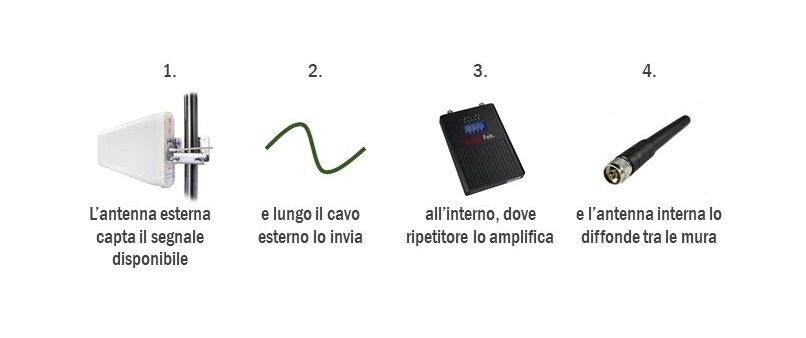
A cellular signal amplifier, also known as a repeater or booster, is a device little larger than a modem that specializes in a particular task: solving cellular reception problems that may be encountered at home, in an office, in an establishment, in an underground parking lot, and many other instances.
- Cell phone reception problems
- What a cellular signal amplifier looks like and how it works
- How to choose the right one
1. Cell phone reception problems
At least once since the advent of cell phones, we have experienced problems with cellular reception; classic examples are the underground parking lot, the office in the city, the garage at home, the beloved rustic cottage in the country. A cellular signal amplifier is designed precisely for these situations and allows us to be on call, make business calls, and check e-mail where it was not possible before.
Not only making phone calls then, but also surfing the Internet: a cellular signal amplifier, depending on the model, can enhance the 2G, 3G and/or 4G cellular signal.
2. What a cellular signal amplifier looks like and how it works
Each cellular signal amplifier, regardless of model, looks like a box the size of a DVD player, is powered by electricity, and has two sockets, one input and one output.
To the first, called input or outdoor, is connected the l'outdoor antenna, and to the second, called indoor or output, is connected the indoor antenna.
That's right, the cellular signal amplifier is not limited to the little box, but to work it needs these two antennas, with a very important task: the external antenna, there on the roof, takes the available cellular signal and along the coaxial cable sends to the repeater (amplifier, indifferently) what it has found and needs to be re-amplified.
The internal antenna, on the other hand, is in charge of spreading the re-created cellular signal within the walls of our home, establishment, office, garage, and so on.
This is the flow of the cellular phone signal:
As we see, there are 4 phases, and the cellular signal amplifier is not the only actor involved. The amplifier itself only amplifies what comes to it; that is why the other components are also vital. And they are all part of the GSM repeater kit, albeit in different variations.
3. How to choose the right one
Choosing the right cellular signal amplifier depends mainly on:
- the size of the environment to be covered
- the amount of signal available externally
- the functions it has (i.e., the networks it works on)
Regarding point 1, the size of the indoor environment we would like to cover (square footage and number of floors) tell us how many indoor antennas we need to equip ourselves with. As a general guideline, let's keep in mind that an indoor antenna reaches a maximum of covering 300sqm.
By knowing the number of indoor antennas, we can identify the right power of the cellular signal amplifier. In this article, we have also published a handy table that allows us to do this calculation quickly.
By knowing the number of internal antennas, we can identify the right power of the cellular signal amplifier.
The amount of external signal also has an impact on choosing the right repeater (point 2), in the sense that if it were to be very low, we would need a slightly more powerful repeater. In other words, if we get at most 2 notches outside, we should consider a slightly more powerful model than necessary.
A small example.
We have a rustic cottage in the mountains of 70 square meters and only need one indoor antenna. The ideal power of the repeater is calculated to be 10 dBm. To learn more about power expressed in decibels refer to this small guide.
However, since the external cellular signal is really poor (we are in the Dolomites, after all!) then our technical friends at GSM Repeater recommend a signal amplifier with slightly higher power, namely 13 dBm.
Point 3 basically says that the choice should be made according to the original goal. We want to solve the problem of:
- calls only (2G network)
- calls and data (2G network + 3G or 4G Internet)
Different frequencies are used for each network, as we have summarized in this article; the more frequencies a cellular signal amplifier "hears," the more its value goes up.
Like a soccer player and his palmares!

